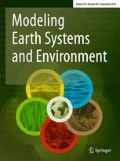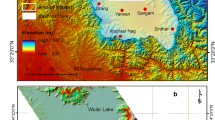Abstract
This paper investigates the application of remote sensing and geographical information systems for detecting land-use/land cover (LULC) changes and assessing its affect by climate change in the southern region of Port Said Governorate, Egypt. Three Landsat images (Landsat TM-5, ETM+7, and Landsat-8) have been utilized to quantify the changes from 1986 to 2016. The Landsat images are useful for this study because of its high spatial and spectral resolution. Calibration techniques, geometric, and atmospheric corrections were utilized to pre-processed the images. Hybrid unsupervised and supervised classification was used as a post-classification technique. Each method used was assessed and checked in the field. Six main and ten subclasses LULC units are recognized and mapping produced for different classes. Landsat images have shown 6 categories of land-use as following: bare land areas, crop vegetation areas, natural vegetation areas, fishpond areas, salt land areas and waterbody areas. The result showed the change that has occurred during 30 years of period. Positive changes areas are displayed in supervised classes of LULC in bare land areas of +51.3 km2; crop vegetation areas about +17.65 km2 and water bodies areas of +9.53 km2. While negative changes areas, are displayed in classes of LULC in natural vegetation areas about −37.16 km2; fish pond areas around −39.36 km2 and salts land areas around −0.58 km2. Unsupervised classification classes have the same way the expression of the increase and decrease and change a rate of changes in supervised classification classes of LULC.








Similar content being viewed by others
References
Bektas F (2003) Remote sensing and geographic information integration: a case study; Bozcaada & Gokceada Island. Msc Thesis, Institution of Science and Technology, Istanbul Technical University
Chen G, Hay GJ, Carvalho LMT, Wulder MA (2012) Object-based change detection. Int J Rem Sens 33(14):4434–4457
Congalton RG (1991) A review of assessing the accuracy of classifications of remotely sensed data. Remote Sens Environ 37:35–46
Coppin P, Jonckheere I, Nackaerts K, Muys B, Lambin E (2004) Digital change detection methods in ecosystem monitoring: a review. Int J Remote Sens 25(9):1565–1596
Dewidar KM (2002) Landfill detection in Hurghada, North Red Sea, Egypt using Thematic Mapper images. Int J Remote Sens 23(5):939–948
Duan H, Ma R, Hu C (2012) Evaluation of remote sensing algorithms for cyanobacterial pigment retrievals during spring bloom formation in several lakes of East China. Rem Sens Environ 126:126–135
Frihy O, Dewidar MK, Nasr S, Elraey M (1998) Change detection of the northeastern Nile Delta of Egypt: shoreline changes, spit evolution, margin changes of Manzala lagoon and its islands. Int J Remote Sens 19:1901–1912
Gautam NC, Narayanan ER (1983) Satellite remote techniques for natural resources survey, Management. edited by LR Singh, Savindra Singh, RC Tiwari and RP Srivastava (Allahabad geophysical society):177–181
Giri C, Zhu Z, Reed B (2005) A comparative analysis of the Global Land Cover 2000 and MODIS land cover data sets. Remote Sens Environ 94(1):123–132
Green K, Kempka D, Lackey L (1994) Using remote sensing to detect and monitoring land-cover and land-use change. Photogramm Eng Remote Sens 60:331–337
Hadjimitsis D, Clayton C, Hope V (2004) An assessment of the effectiveness of atmospheric correction algorithms through the remote sensing of some reservoirs. Int J Remote Sens 25(18):3651–3674
Hardin PJ, Jackson MW, Otterstrom SM (2007) Mapping, measuring, and modeling urban growth. In: R Jensen R, D Gatrell J, McLean D (eds) Geo-spatial technologies in urban environments: Policy, practice and pixels, 2nd edn. Springer-Verlag, Heidelberg, pp 141–176
Hartter J, Lucas C, Gaughan AE, Aranda LL (2008) Detecting tropical dry forest succession in a shifting cultivation mosaic of the Yucata´n Peninsula, Mexico. Appl Geogr 28:134–149
Jensen JR (2005) Introductory digital image processing: a remote sensing perspective. John R Jensen, 3rd edn. Pearson Education Inc, Upper Saddle River
Johnson RD, Kasischke ES (1998) Change vector analysis: a technique for the multi-temporal monitoring of land cover and condition. Int J Remote Sens 19:411–426
Landis J, Koch GG (1977) The measurement of observer agreement for categorical data. Biometrics 33:159–174
Li X, Yeh AGO (1998) Principal component analysis of stacked multi-temporal images for the monitoring of rapid urban expansion in the Pearl River Delta. Int J Remote Sens 19:1501–1518
Lillesand TM, Kiefer RW (2000) Remote sensing and image interpretation. John Wiley&. Sons Inc, New York
Lillesand T, Kiefer R (2008) Chipman JW., Remote sensing and image interpretation. 6th ed. John Wiley & Sons, Hoboken
Lillesand T, Kiefer R, Chipman J (2004) Remote sensing and image interpretation. 5th edn. John Wiley and sons, Inc, Hoboken
Lu D, Mausel P, Brondiozio E, Moran E (2004) Change detection techniques. Int J Remote Sens 25(12):2365–2407
Macleod RD, Congalton RGA (1998) Quantitative comparison of change-detection algorithms for monitoring eelgrass from remotely sensed data. Photogramm Eng Remote Sens 64 (3):207–216
Moufaddal W (2005) Use of satellite imagery as environmental impact assessment tool: a case study from the NW Egyptian Red Sea Coastal Zone. Environ Monit Assess 107(1–3):427–452
Mundia C, Aniya M (2005) Analysis of land use/cover changes and urban expansion of Nairobi city using remote sensing and GIS. Int J Remote Sens 26(13):2831–2849
Nelson RF (1983) Detecting forest canopy changes due to insect activity using Landsat MSS. Photogramm Eng Remote Sens 49:1303–1314
Omran ESE (2008) Is soil science dead and buried? Future image in the world of 10 billion people. CATRINA 3 (2):59–68
Omran ESE (2009) A proposed simplified method to improve land-use mapping accuracy. Agric Res J 9 (3):123–132.
Omran ESE (2012) Detection of land-use and surface temperature change at different resolutions. J Geogr Inf Syst 4(3):189–203. doi:10.4236/jgis.2012.43024
Omran ESE (2015) Remote estimation of vegetation parameters using narrowband sensor for precision agriculture in arid environment. Egypt J Soil Sci 55(4)
Pham H, Yamaguchi Y, Bui T (2011) A case study on the relation between city planning and urban growth using remote sensing and spatial metrics. Landscape Urban Planning 100(3):223–230
Serra P, Pons X, Saurı D (2008) Land-cover and land-use change in a Mediterranean landscape: a spatial analysis of driving forces integrating biophysical and human factors. Appl Geogr 28:189–209
Shalaby A, Tateishi R (2007) Remote sensing and GIS for mapping and monitoring land cover and land-use changes in the Northwestern coastal zone of Egypt. Appl Geogr 27(1):28–41
Tahoun SA (2007) The European Union’s short and medium-term priority environmental action programme (SMAP) “plan of action for an integrated coastal zone management in the area of port said (Egypt)”. Intersectoral Analysis in Coastal Zone Environmental Perspectives of the Port Said Area Contract n. MED/2005/112–172 ACTION 4
Toll DL, Royal J, Davis JB (1980) Urban area update procedures using Landsat data. In Proceedings of the fall Technical Meeting of the American Society of Photogrammetry held in Niagara Falls, Canada, 1980, edited by ASP (Falls Church, Virginia: ASP):RS-E1-17
Townshend JRG, Justice CO (1995) Spatial variability of images and the monitoring of changes in the normalized difference vegetation index. Int J Remote Sens 16:2187–2195
Wang SY, Liu JS, Ma TB (2010) Dynamics and changes in spatial patterns of land use in Yellow River Basin, China. Land Use Pol 27 (2):313–323
Weber C, Puissant A (2003) Urbanization pressure and modeling of urban growth: example of the Tunis Metropolitan Area. Remote Sens Environ 86(3):341–352
Yuan F, Sawaya KE, Loeffelholz BC, Bauer ME (2005) Land cover classification and change analysis of the Twin Cities (Minnesota) Metropolitan Area by multi-temporal Landsat remote sensing. Remote Sens Environ 98(2–3):317–328
Author information
Authors and Affiliations
Corresponding author
Rights and permissions
About this article
Cite this article
Hassan, M.A.E.R., Omran, ES.E. Modelling of land-use changes and their effects by climate change at the southern region of Port Said governorate, Egypt. Model. Earth Syst. Environ. 3, 13 (2017). https://doi.org/10.1007/s40808-017-0276-1
Received:
Accepted:
Published:
DOI: https://doi.org/10.1007/s40808-017-0276-1




